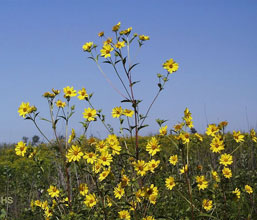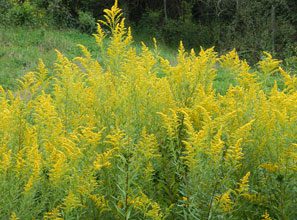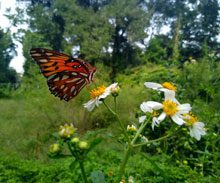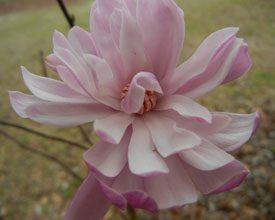 There’s something predictable about the burst of bloom which appears as the too intense heat and sun of midsummer start to wane. There’s so much yellow, as if the high solstice of June left shards of itself to reappear as rayed flowers to carry on its brilliant intensity into the fall.
There’s something predictable about the burst of bloom which appears as the too intense heat and sun of midsummer start to wane. There’s so much yellow, as if the high solstice of June left shards of itself to reappear as rayed flowers to carry on its brilliant intensity into the fall.
Roadsides and ditches, places where moisture sometimes accumulates, offer tempting spots for several of these handsome native species. The Giant Sunflower, Helianthus giganteus, will show up in great clumps of tall reddish stems cloaked in dark green leaves. Growing easily to ten feet in height, the Giant Sunflower will celebrate October with massive heads of dozens of sunflower blooms over several weeks. You will understand that the name comes not from the size of the individual flower, but from the height of the plant.
In similar sites in late summer, there is often a much lower-growing yellow daisy-flowered plant, the garden coreopsis, Coreopsis tinctoria. Growing perhaps four feet tall, the coreopsis flower has a distinct reddish-brown spot at the base of the yellow petals. The even shorter lance-leaved coreopsis, growing to two feet, lacks the brownish spot on the petal; it blooms in late spring and appears in drier sandy locations.
The goldenrods, all in the genus Solidago, comprise dozens of different kinds of plants and  different types of blooms – just in the Coastal Plain. Worldwide, Solidago includes more than a hundred species. Slow down as you drive along our roads this time of year to really notice the various forms of goldenrod you encounter. You’ll likely spot Solidago gigantea, Tall Goldenrod, with airy flower heads of dozens of flower stems crammed with tiny yellow flowers. There’s Solidago rigida, Stiff Goldenrod, whose clumps of hairy-leaved plants topped with dense spreading flower heads are often nearby the other types of goldenrod. There are very tall stands of Seaside Goldenrod, Solidago sempervirens; pencil-thin yellow spikes of Solidago stricta, the Wand Goldenrod; and several other species which occur all over our area.
different types of blooms – just in the Coastal Plain. Worldwide, Solidago includes more than a hundred species. Slow down as you drive along our roads this time of year to really notice the various forms of goldenrod you encounter. You’ll likely spot Solidago gigantea, Tall Goldenrod, with airy flower heads of dozens of flower stems crammed with tiny yellow flowers. There’s Solidago rigida, Stiff Goldenrod, whose clumps of hairy-leaved plants topped with dense spreading flower heads are often nearby the other types of goldenrod. There are very tall stands of Seaside Goldenrod, Solidago sempervirens; pencil-thin yellow spikes of Solidago stricta, the Wand Goldenrod; and several other species which occur all over our area.
Late summer and fall, of course, are not just yellow-flowering times. Eight-foot stems supporting great heads of the most intense heliotrope purple flowers show up along roadsides this time of year. It’s ironweed, Vernonia species, and takes the breath away with its beauty.
Of course, if I’m going to mention shocking color, the berry display of the American Beautyberry, Callicarpa americana, always draws comments. The stems of this shrub, perhaps four to six feet in length, have ball-shaped clusters of berries of an impossibly violet-purple color at the leaf nodes along the stem. A well-grown bush may be six or eight feet tall, equally wide, and with hundreds of these big violet clusters all over. Awesome!
I was driving into a nearby county landfill this week, past the spot where I had found native Bluestar blooming one year in the sandy clay along the roadside; I spotted the native Blazing Star, Liatris species, in bloom. Some species are quite invasive, but these – which I think appear to be Liatris ligustylis – seem to be struggling where they are. I’ll keep an eye on them.
There’s a shrub which appears along waterways and roadside, its greenish-gray leaves covering a bush which may grow ten feet high. This time of year, it becomes covered in massive clouds of white, an astonishing sight to first time witnesses, and inevitably boaters and newcomers are sufficiently amazed to ask repeatedly what the shrub is. It is the native groundsel bush, Baccharis halimifolia, and the female plants produce great showy white cottony heads which cause such envy. The plant is unusually salt tolerant, so it is often found along tidal salt marshes. Here’s a wonderful photo of Baccharis, taken by quantum-mechanics specialist Alexey Sergeev in Texas. The salt-bush is backed up by the tallow tree, Triadica sebiferum, an invasive interloper, but spectacular in the fall.
Late summer into the fall: it’s nice to see the flowers again. Next, it’ll be the tree leaves that put on the show.








